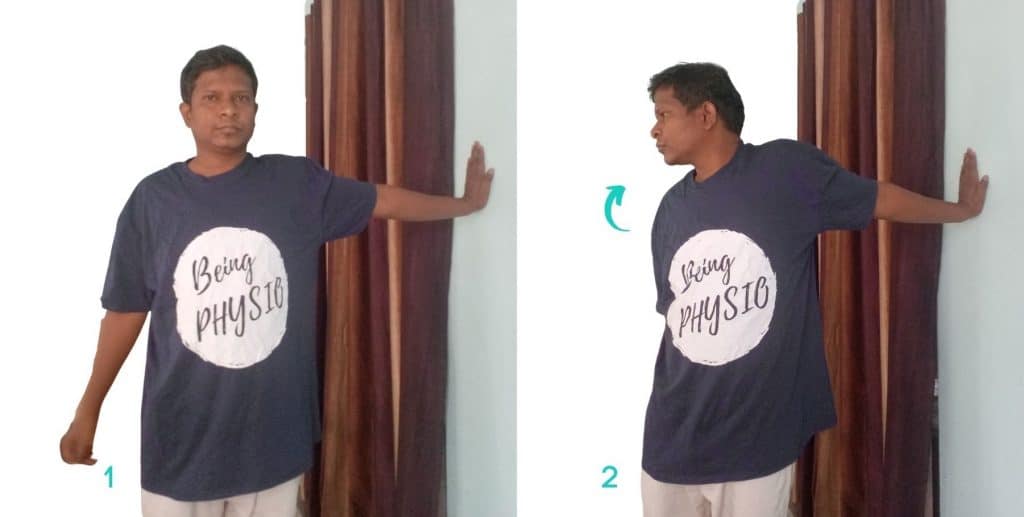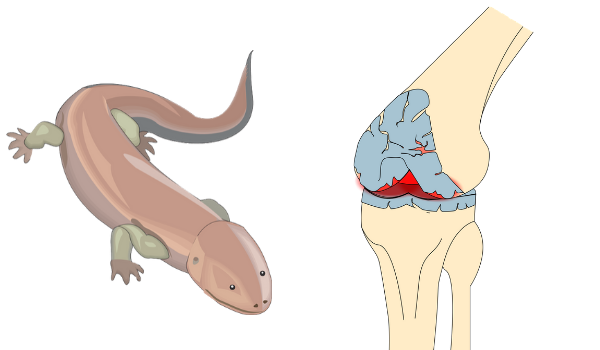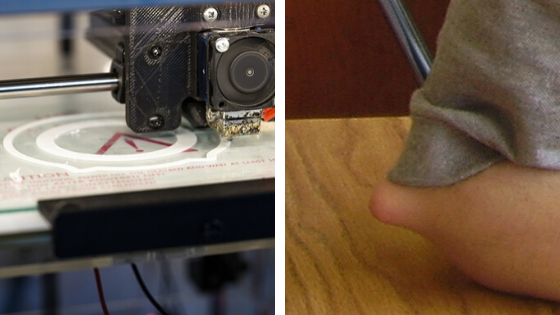Last updated on February 27th, 2025 at 11:42 am
The resistance band exercises for shoulders can be done in many shoulder conditions, such as the frozen shoulder, shoulder impingement syndrome, shoulder dislocation or simply shoulder stability exercises with bands. Also, these exercises are beneficial to prevent recurrent shoulder dislocation1.
Or you have some kind of paralysis, such as brachial plexus injury, due to which if the shoulder has become weak, there is mild paresis, you can do this exercise in these conditions too. You can also do this for shoulder pain as well.
In this article, we will discuss five very easy yet very effective shoulder-strengthening exercises using the resistance band. So, let us start straight away.
5 Easy band exercises for shoulders
#1 Shoulder abduction strengthening exercises with theraband
So, the first exercise among band exercises for shoulders is shoulder abductor strengthening exercises, which strengthen the muscles on the outer side of our shoulder. The muscles outside our shoulders are called shoulder abductor muscles, and their action brings abduction motion to the shoulder. These muscles are,
- Supraspinatus: It is responsible for the first 0 to 15 degrees of abduction,
- Middle fibres of the deltoid: They are responsible for approximately 15 to 90 degrees of abduction following.
- Trapezius and serratus anterior: Scapular rotation due to the actions of the trapezius and serratus anterior allows for abduction beyond 90 degrees.
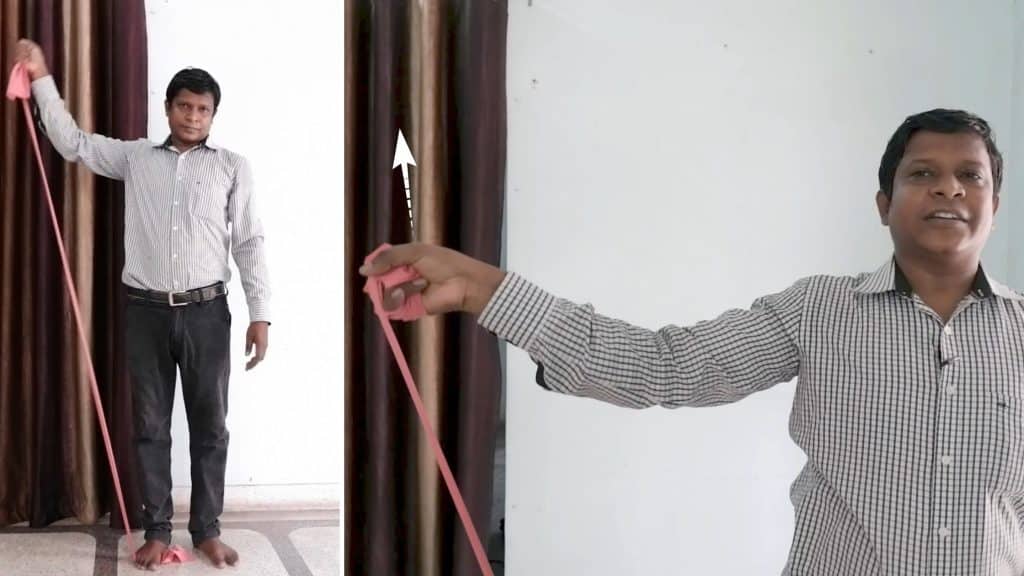
Shoulder abduction is an exercise that involves taking the shoulder away from the body sideways. This exercise is essential for strengthening the shoulders and improving their flexibility.
If you’re looking for an easy way to do this exercise, all you need is a resistance band.
- To start with, hold one end of the resistance band firmly in your hands and press the other end with your foot on the floor.
- Stand in a normal position with your hands by your side, and then begin the shoulder abduction motion by pulling the band against its resistance. It’s important to firmly hold the band on the floor by your foot and not let it release.
- As you pull the band, you’ll feel the resistance, similar to lifting weights. However, with the help of the resistance band, you can do this exercise more easily.
- Repeat this motion at least 15 to 20 times in a session, making sure to maintain proper form throughout the exercise.
- After completing the recommended repetitions, switch sides and repeat the exercise with the other shoulder.
- Press the band under the foot of the other side, hold it with the other hand, and then make the shoulder abduction motion again.
#2 Shoulder flexion with theraband
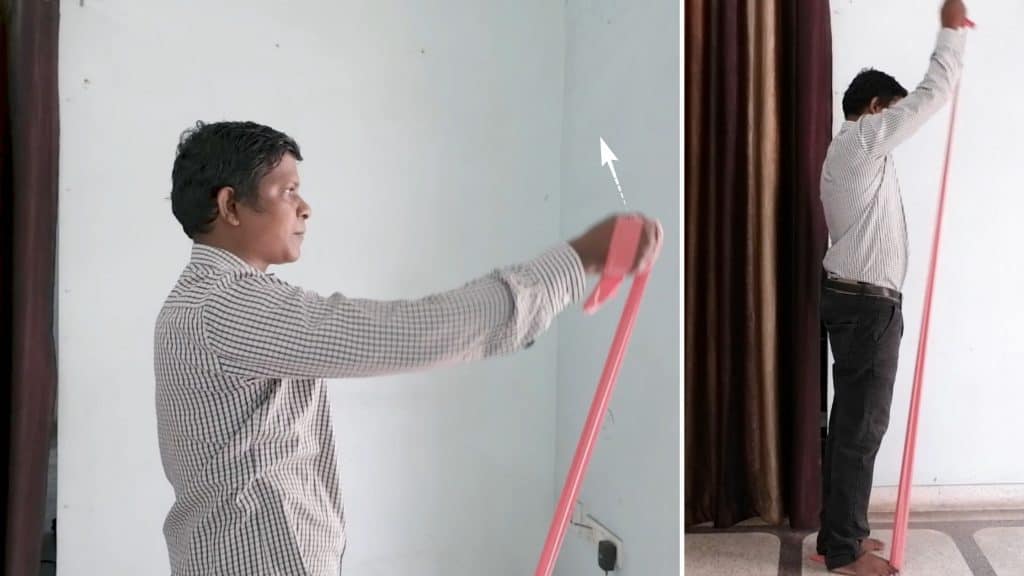
The next exercise we will focus on is shoulder flexor strengthening. The shoulder flexor muscles are a group of muscles located on the front part of the shoulder. These muscles are responsible for bringing about flexion movement in the shoulder.
When we elevate our shoulder in front of our body, we call it shoulder flexion, which is also known as shoulder elevation. The strengthening of these muscles is relatively easy.
- To begin, you will need a resistance band. Hold one end of the band in your hand and press the other with your foot, ensuring the band is firmly fixed to the floor.
- Next, elevate your shoulder against the resistance of the band. You can refer to the figure or image provided to better understand the procedure.
- Slowly lower your shoulder to its normal position and repeat this movement 10 to 15 times in a session.
- You can increase the number of repetitions as you become more comfortable with the exercise.
- Once you have completed the desired number of repetitions on one side, repeat the same procedure on the other. This will ensure that both sides of your shoulders get equal attention and strengthening.
#3 Internal rotation of shoulder with theraband
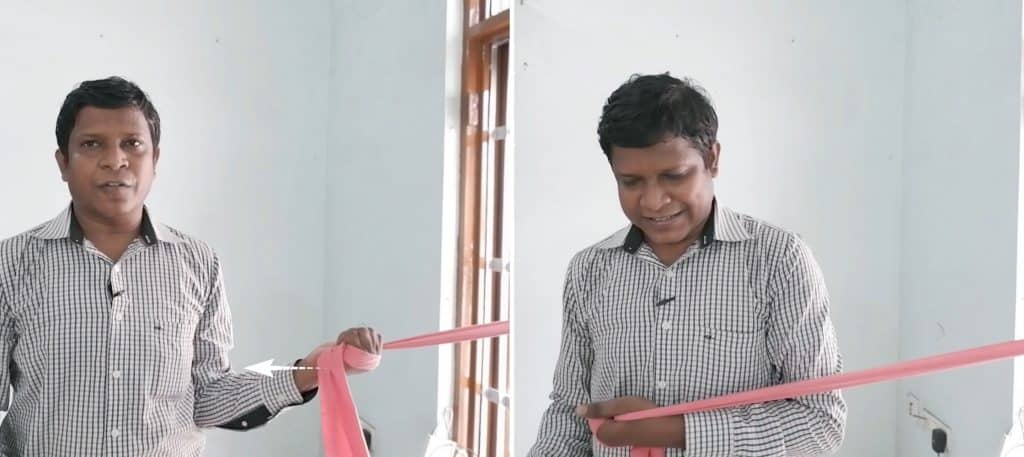
To strengthen the internal rotators of the shoulder, we need to focus on the five muscles responsible for internal rotation movement: the subscapularis, pectoralis major, latissimus dorsi, teres major, and the anterior aspect of the deltoid.
The basic principle for all the strengthening exercises is the same. We need a resistance band, tie one end of the band on a sturdy object, such as a window grill, and hold the other end with the hand to be exercised.
- To get the maximum range of motion, start with the hand rotated externally and the resistance band in the tout position.
- Then, firmly pull the band and do an internal rotation movement of the shoulder against the band’s resistance. Take it to the maximum internally rotated position and slowly return it to the starting position.
- Doing this exercise at least 15 to 20 times in a session is recommended, repeating the same procedure on the other shoulder by tying the resistance band on the opposite side.
- For better results, do it at least 10 to 15 times at a time.
Also Read: 4 Easy Shoulder Wand Exercises for Painful, Stiff Shoulder
#4 Theraband exercises for shoulder external rotator
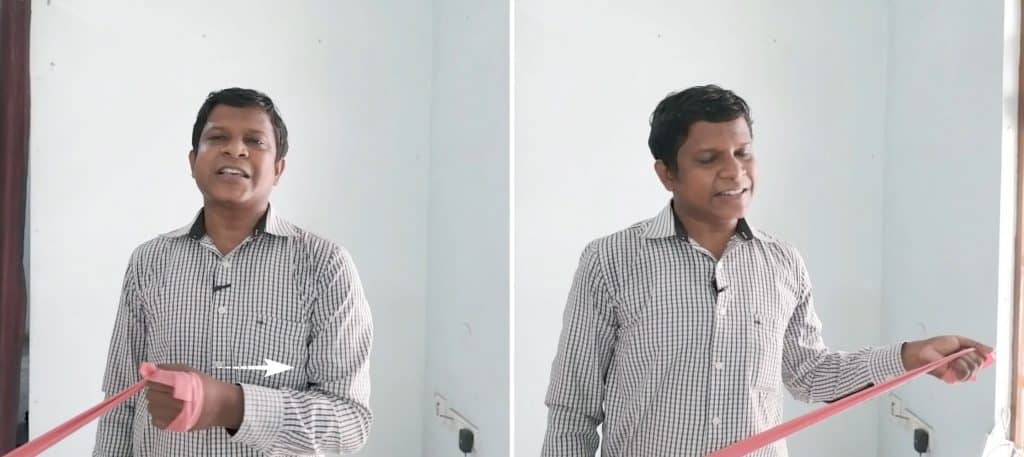
In this exercise, we will be focusing on strengthening the muscles responsible for shoulder external rotation. As you may already know, external rotation is the opposite movement of internal rotation, and the primary muscles responsible for this motion are the infraspinatus and teres minor.
To perform this exercise, you will need a resistance band and a chair or any stable object to anchor the band. In our previous exercise, we tied the resistance band on the same side of the hand in the question, but for this exercise, we needed to do the exact opposite.
For example, if you want to perform the exercise on your left shoulder, you will need to tie the resistance band on the right side of the chair.
- Once you have anchored the resistance band, grab the other end with your hand. Start by taking your hand to an extremely internally rotated position and keeping the band taut.
- Then, against the band’s resistance, do shoulder external rotation motion. Take the rotation to its maximum external range and slowly return it to the starting position.
- This will help to strengthen the external rotators of your shoulder.
- Performing this exercise at least 15 to 20 times in a session is recommended.
- A superior band product for resistance training and rehabilitation, provides both positive and negative force on muscles…
- Simple & easy to use product for upper & lower body exercises that can be performed anywhere, is ideal for conditioning …
- Color-coded Progressive Resistance system allows users to recognize improvement as it happens, as you grow stronger you …

#5 Shoulder retraction exercise with rehab band

The shoulder retractor strengthening exercise is one that can be highly effective in building up the muscles around your shoulder blades.
This exercise involves a simple motion known as shoulder retraction, which involves pulling both shoulders back so that your two shoulder blades come closer together.
- To perform the exercise, stand before a window or other flat surface, ensuring you have enough space to move your arms freely.
- Take a resistance band and tangle it well, then hold it with both hands, keeping your arms straight out in front of you at shoulder height.
- Next, pull your shoulders back and down, squeezing your shoulder blades together. You should feel a stretch in the muscles between your shoulder blades, known as the shoulder retractors.
- Hold this position for a few seconds, then release and repeat the motion. Make sure to use enough resistance to feel the muscles working, but not so much that you strain your shoulders or neck.
- Aim to perform the exercise at least 15 to 20 times during each session, and gradually increase the number of repetitions as your strength improves.
Final take away
Incorporating resistance band exercises into your workout routine can be an effective way to improve strength, flexibility, and range of motion. By following proper form and gradually increasing resistance, you can target specific muscles and achieve your fitness goals.
Additionally, resistance band exercises are a convenient and affordable option for those who prefer to workout at home or on the go. So, whether you’re a beginner or an experienced fitness enthusiast, adding resistance band exercises to your routine can offer a variety of benefits for your overall health and wellness.
Keep Reading: 9 Best Exercise for Shoulders to Fix stiff, painful shoulder
The author is a physiotherapist who has been practising for the last 17 years. He holds a Bachelor's in Physiotherapy (BPT) from SVNIRTAR (Swami Vivekananda National Institute of Rehabilitation and Research), one of the prestigious physiotherapy schools in India.
Whatever he learns dealing with his patient, he shares it with the world through blogs and e-books. He also owns a YouTube channel, "Sunit Physiotherapist" with over 8 lakh active subscribers. Here, he shares everything he gets to learn serving the patient.



